
Concept explainers
A 1-Ib ball A and a 2-Ib ball B are mounted on a horizontal rod that rotates freely about a vertical shaft. The balls are held in the positions shown by pins. The pin holding B is suddenly removed and the ball moves to position C as the rod rotates. Neglecting friction and the mass of the rod and knowing that the initial speed of A is

(a)
Radial and transverse component of acceleration of ball B immediately after the pin is removed.
Answer to Problem 12.91P
Radial component:
Transverse component:
Explanation of Solution
Given:
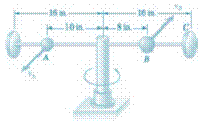
Let
Constraint of rod:
Components of acceleration:
Sketch the free body diagrams of the balls showing the radial and transverse components of the forces acting on them.
Owing to frictionless sliding of B along the rod,
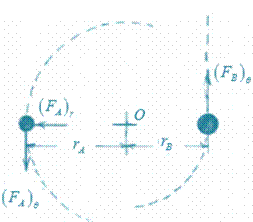
Radial component of acceleration of B.
Transverse components of acceleration,
Since the rod has no mass, it must be in equilibrium.
Draw its free body diagram, applying Newton’s third law:
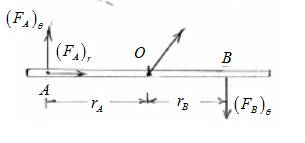
 m:math display='block'>
m:math display='block'>
At
So that
From Eq. (1),
(b)
Acceleration of ball B relative to rod.
Answer to Problem 12.91P
Acceleration of ball B relative to rod:
Explanation of Solution
Given:
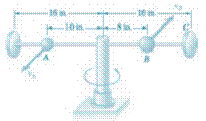
Acceleration of B relative to the rod,
At
(c)
Acceleration of ball B relative to rod.
Answer to Problem 12.91P
Acceleration of ball B relative to rod:
Explanation of Solution
Given:
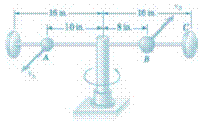
Speed of A:
Substituting
Integrating with respect to time,
Applying to the final state with ball B moved to the stop at C,
Want to see more full solutions like this?
Chapter 12 Solutions
Vector Mechanics For Engineers
- F The retractable shelf shown is supported by two identical linkage-and-spring systems; only one of the systems is shown. A 20-kg machine is placed on the shelf so that half of its weight is supported B 300 mm 30° 30° E by the system shown. If the springs are removed and the system is released from rest, determine (a) the acceleration of the machine, (b) the D 80 mm 100 mm A 80 mm | 30° tension in link AB. Neglect the weight of the shelf 200 mm and links. 50 mm 100 mmarrow_forwardIn the design of a timing mechanism, the motion of pin P in the fixed circular slot is controlled by the guide A, which is being elevated by its lead screw. Guide A starts from rest with pin P at the lowest point in the circular slot, and accelerates upward at a constant rate until it reaches a speed of 130 mm/s at the halfway point of its vertical displacement. The guide then decelerates at a constant rate and comes to a stop with pin P at the uppermost point in the circular slot. Determine the n- and t-components of acceleration of pin P once the pin has traveled 29° around the slot from the starting position. Please solve step by steparrow_forwardF |de| 30° The support bracket shown is used to transport a cylindrical can from one elevation to another. Knowing that µs = 0.47 between the can and the bracket, determine the magnitude of the upward acceleration a for which the can will slide on the bracket.arrow_forward
- In the design of a timing mechanism, the motion of pin P in the fixed circular slot is controlled by the guide A, which is being elevated by its lead screw. Guide A starts from rest with pin P at the lowest point in the circular slot, and accelerates upward at a constant rate until it reaches a speed of 90 mm/s at the halfway point of its vertical displacement. The guide then decelerates at a constant rate and comes to a stop with pin P at the uppermost point in the circular slot. Determine the n- and t-components of acceleration of pin P once the pin has traveled 23° around the slot from the starting position.arrow_forwardProblem (2) A turntable is used to test an intentionally weak adhesive by coating the bottom of a 0.3 kg block with the adhesive and pressing it firmly to the turntable 0.4 meters from its center. The turntable starts from rest at t = 0 and uniformly accelerates with an angular acceleration of a = 4.5 rad/s?. If the adhesive fails exactly 2 seconds after the turntable starts rotating determine: (a) The angular displacement of the turntable at the time of failure. (b) The number of revolutions the turntable has made at the time of failure. (c) The total shear force which the adhesive supports given this failure. 0.4 marrow_forwardTwo friction disks A and B are to be brought into contact without slipping when the angular velocity of disk A is 240 rpm counterclockwise. Disk A starts from rest at time t= 0 and is given a constant angular acceleration with a magnitude a. Disk B starts from rest at time t= 2 s and is given a constant clockwise angular acceleration, also with a magnitude a. Determine (a) the required angular acceleration magnitude a, (b) the time at which the contact occurs.arrow_forward
- A 0.5-kg block B slides without friction inside a slot cut in arm OA that rotates in a vertical plane. The rod has a constant angular acceleration 0= 10 rad/s2. Knowing that when 0= 45° and r= 0.8 m the velocity of the block is zero, determine at this instant, (a) the force exerted on the block by the arm, (b) the relative acceleration of the block with respect to the arm.arrow_forward8. A block (mass m1) lying on a frictionless inclined plane is connected to a mass m2 by a massless cord passing over a pulley. (a) Determine a formula for the acceleration of the system of the two blocks in terms of m1, m2, Theta, and g. (b ) What conditions apply to masses m1, and m2 for the acceleration to be in one direction (say m1 down the plan) or in the opposite direction ?arrow_forwardThe 15-kg block B is supported by the 25-kg block A and is attached to a cord to which a 225-N horizontal force is applied as shown. Neglecting friction, determine (a) the acceleration of block A, (b) the acceleration of block B relative to A.arrow_forward
- To transport a series of bundles of shingles A to a roof, a contractor uses a motor-driven lift consisting of a horizontal platform BC which rides on rails attached to the sides of a ladder. The lift starts from rest and initially moves with a constant acceleration a1 as shown. The lift then decelerates at a constant rate a2 and comes to rest at D , near the top of the ladder. Knowing that the coefficient of static friction between a bundle of shingles and the horizontal platform is 0.30, determine the largest allowable acceleration a1 and the largest allowable deceleration a2 if the bundle is not to slide on the platform.arrow_forwardPin A, which is attached to link AB, is constrained to move in the circular slot CD. Knowingthat at t=0 the pin starts from rest and moves so that its speed increases at a constant rate of 0.8in/s 2 , determine the magnitude of its total acceleration when (a) t=0, (b) t=2 sarrow_forwardTo transport a series of bundles of shingles A to a roof, a contractor uses a motor-driven lift consisting of a horizontal platform BC which rides on rails attached to the sides of a ladder. The lift starts from rest and initially moves with a D constant acceleration a1 as shown. The lift then decelerates at a constant rate a2 and comes to rest at D, near the top of the ladder. Knowing that the coefficient of static friction between a bundle of shingles and the horizontal platform is 0.30, determine the largest allowable acceleration a1 and the largest allowable deceleration az if the bundle is not to slide on the platform. 4.4 m 65° A B 0.8 marrow_forward
 Elements Of ElectromagneticsMechanical EngineeringISBN:9780190698614Author:Sadiku, Matthew N. O.Publisher:Oxford University Press
Elements Of ElectromagneticsMechanical EngineeringISBN:9780190698614Author:Sadiku, Matthew N. O.Publisher:Oxford University Press Mechanics of Materials (10th Edition)Mechanical EngineeringISBN:9780134319650Author:Russell C. HibbelerPublisher:PEARSON
Mechanics of Materials (10th Edition)Mechanical EngineeringISBN:9780134319650Author:Russell C. HibbelerPublisher:PEARSON Thermodynamics: An Engineering ApproachMechanical EngineeringISBN:9781259822674Author:Yunus A. Cengel Dr., Michael A. BolesPublisher:McGraw-Hill Education
Thermodynamics: An Engineering ApproachMechanical EngineeringISBN:9781259822674Author:Yunus A. Cengel Dr., Michael A. BolesPublisher:McGraw-Hill Education Control Systems EngineeringMechanical EngineeringISBN:9781118170519Author:Norman S. NisePublisher:WILEY
Control Systems EngineeringMechanical EngineeringISBN:9781118170519Author:Norman S. NisePublisher:WILEY Mechanics of Materials (MindTap Course List)Mechanical EngineeringISBN:9781337093347Author:Barry J. Goodno, James M. GerePublisher:Cengage Learning
Mechanics of Materials (MindTap Course List)Mechanical EngineeringISBN:9781337093347Author:Barry J. Goodno, James M. GerePublisher:Cengage Learning Engineering Mechanics: StaticsMechanical EngineeringISBN:9781118807330Author:James L. Meriam, L. G. Kraige, J. N. BoltonPublisher:WILEY
Engineering Mechanics: StaticsMechanical EngineeringISBN:9781118807330Author:James L. Meriam, L. G. Kraige, J. N. BoltonPublisher:WILEY





